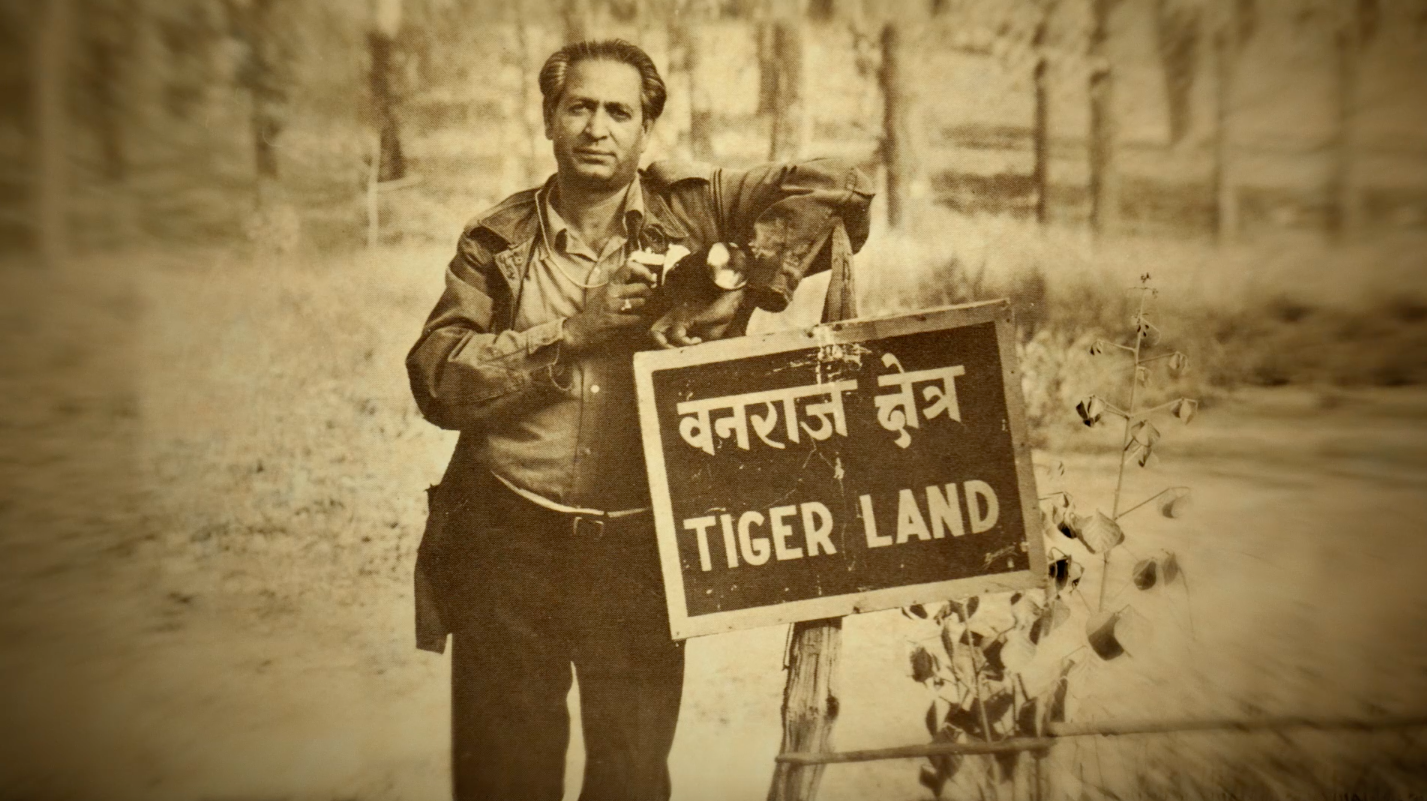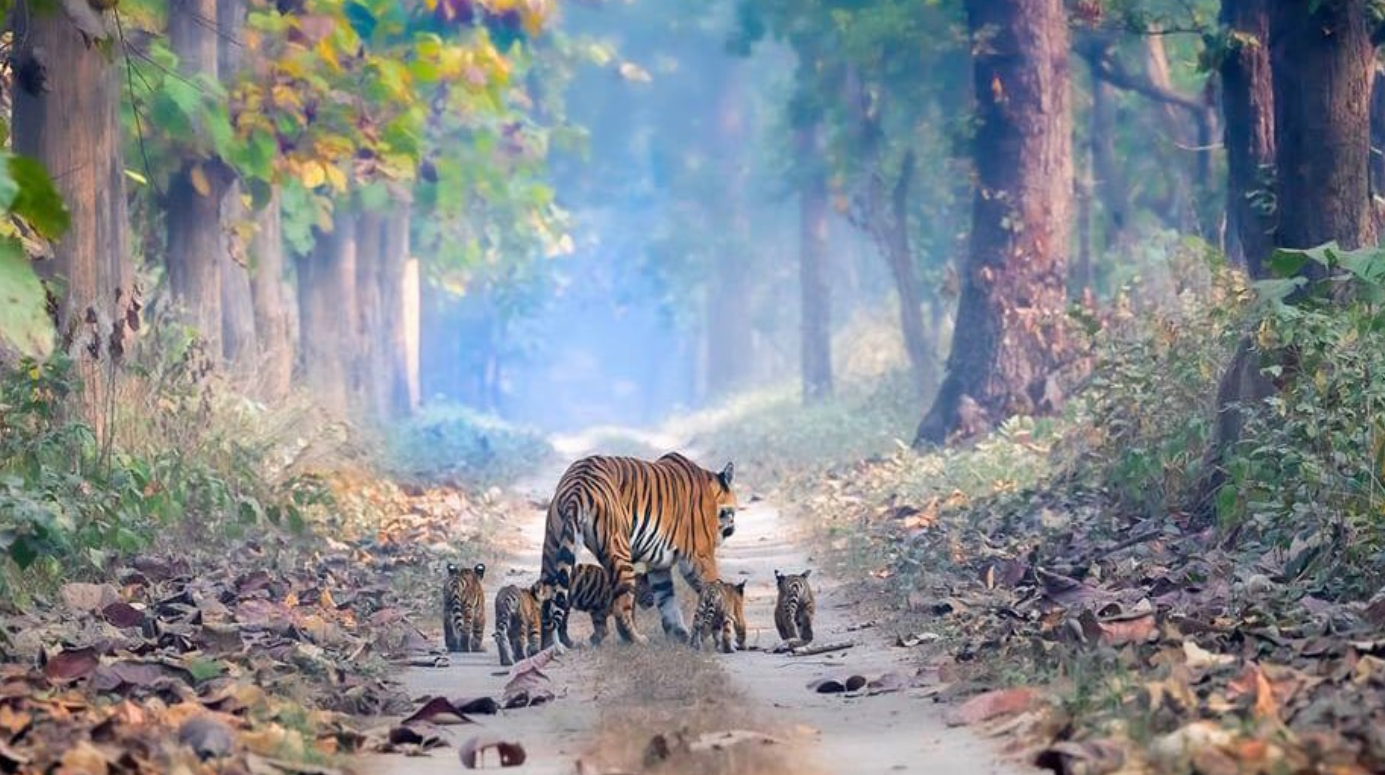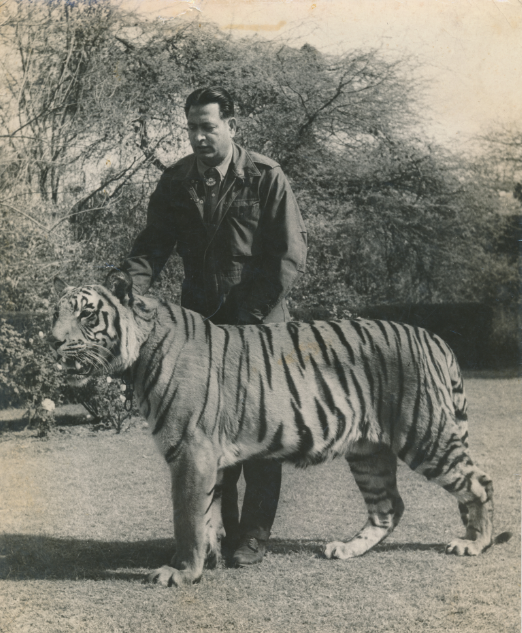Guilt-Stricken On Killing a Tiger, Padma Shri Officer Went On To Change Their Destiny in India
"There seems to be something about India's soil that inspires conservation and humbles man,” wrote Padma Shri Kailash Sankhala, better known as India's Tiger Man. #UnsungHeroes

Our history is replete with stories of elaborate big game hunts, particularly of tigers and leopards, that were a favourite pastime of royal families in the Indian subcontinent. These events were often staged to showcase their royalty, power, wealth and, of course, machismo.
Officers of the British government routinely hunted down these wild cats with reckless abandon, alongside their Indian vassals that ruled over nominally sovereign ‘princely states.’
Post-independence, however, the killing of tigers escalated. Hunters from around the world gathered in India with local travel agencies promising them marquee trophies of animals including tigers, elephants, lions and the rhinos, amongst others. And leading the pack were the Maharajas.
Serious scientific research in the field of wildlife conservation only began in the country when renowned wildlife biologist, George Schaller came to India in the 1960s. Prior to his arrival, most of the stories surrounding wildlife were written by Britishers who were working with the Raj when hunting was allowed whether he was Jim Corbett or anyone else. People were fascinated more with the aesthetics of tigers and eventually killing them, and we saw the gradual disappearance of the strongest cats from the gene pool.
After visiting a series of forest areas like Kanha, George Schaller wrote a popular book titled ‘The Deer and The Tiger’ published in 1967, which offered a detailed account of the ecology and behaviour of Bengal tigers and four species of the hoofed mammal.
However, wildlife conservation in India really took off in the early 1970s, which saw the enactment of the Wildlife Protection Act (1972), the establishment of Project Tiger (1973), signing onto the Stockholm Declaration (1972) and Convention on International Trade in Endangered Species (CITES) of Wild Fauna and Flora (1973).
Kailash Sankhala, the first director of Project Tiger, would go on to play a fundamental role in turning the tide for wildlife conservation in India, particularly of tigers. He was probably the first Indian field officer who did real field research work in understanding the secretive lives of tigers from their behaviour, population dynamics to daily activities.
Territorial fight between two full grown #tigers. Listen with headphones. Powerful Roar & it’s echo from Indian #forests. Via WA. Today project tiger has completed 47 years in #India. pic.twitter.com/hiLonKXrif
— Parveen Kaswan, IFS (@ParveenKaswan) April 1, 2020
Early Life
Born in Jodhpur on 30 January 1925, Sankhala studied biology in college despite his father’s wish that he study engineering.
Following college, he did his Master’s from Jaswant College in Jodhpur before earning a postgraduate degree in Forestry from the Indian Forest College in 1953. The same year he joined the Forest Service in Rajasthan, a “place that shaped me and my future career,” wrote Sankhala in his book ‘Tiger! The Story of the Indian Tiger.’
“Before his passion of conservation was ignited, he was responsible for issuing hunting permits. One day sometime in the early 1950s, he killed a tiger which transformed him. It was a real turning point. He was riddled with guilt, which eventually led to him becoming a conservationist. He spent the remainder of his life protecting the tiger and its habitat,” says Amit Sankhala, the Managing Director of the Bandhavgarh Jungle Lodge, and grandson of Kailash Sankhala, in an email interview with The Better India.

It’s something Kailash Sankhala notes as well. “Even today, the scene is as fresh as it was that morning, and the open eyes of that tiger have haunted me all my life. To overcome my guilt, I have dedicated my life to the cause of tiger preservation,” he writes in his book.
In 1956, he sent a letter to the Wildlife Board of Rajasthan with an appeal to stop the shooting of tigers and thus became one of the first conservationists to speak up for their protection.
Nearly a decade later, when he was appointed Director of the Delhi Zoological Park, he convinced the Indian Board of Wildlife to institute a system that would track the export of tiger cubs, requiring exporters to clearly explain how they obtained them.
For the Tiger
It was during his time as the Director of Delhi Zoological Zoo from 1965 to 1970, when his work around tigers really began to pick up. Despite protests by the local media, he stopped making animals perform for the general public while revamping the quarters where tigers were kept more like their natural habitat. He also started conducting some of his initial research on tigers nearby and travelling to different parts to get population estimates.
In 1967, he investigated the sale of tiger and leopard furs in markets across Delhi and published those findings on the front page of The Indian Express. Two years later, he pleaded before the International Union for Conservation of Nature (IUCN) to protect the tiger whose numbers were rapidly declining.
In fact, by gathering public support on this issue in the national and international media, he persuaded the then Prime Minister Indira Gandhi to ban tiger hunting altogether. Even some of the Maharajas saw the wisdom of this plea.
“Going on Tiger Hunts, was a regular pastime of the Maharajas. They could never imagine that one day there would be Indian jungles without any tigers in them,” says Amit.
In May 1970, he was awarded the coveted Jawaharlal Nehru fellowship for his project titled ‘The Controversial Tiger: A Study of Ecology, Behaviour and Status,’ which truly enabled him to jump with both feet into the field of wildlife conservation. Under the fellowship, he set out to conduct an all India study to understand how many Tigers were still alive in India.
By September 1970, he had convinced Dr Karan Singh, the Minister of Tourism and Civil Aviation, to ban the export of tiger, leopard and panther skins or the products made from them.
For the next two years, he travelled across India to study the dwindling tiger population. Amid his project, Anne Wright, a leading voice for wildlife conservation, published an article in May 1971 titled Skin Shops, which describes in some harrowing detail the illegal selling of tiger and leopard skins in Kolkata. This was once again part of a concerted effort to raise the issue of tiger conservation into mainstream discourse.
After she was convinced of the problem by British conservationist Guy Mountfort, Prime Minister Indira Gandhi established India’s first Task Force on Tigers, headed by Dr Karan Singh. The Task Force on Tigers also included Kailash Sankhala, Anne Wright, Dr MK Ranjitsinh, an authority on wildlife, and Zafar Futehally, a naturalist and conservationist.

Months later on 9 September 1972, the parliament passed the Wildlife Protection Act for the protection of plants and animal species.
It was a landmark piece of legislation which among other things, facilitated the creation of wildlife sanctuaries and national parks, strictly restricted and regulated activities in them, besides banning the hunting of wildlife.
A few months later in April 1973, Prime Minister Gandhi established Project Tiger to “protect and restore natural habitats of tigers and to track and protect the remaining wild tigers in India” and handpicked Sankhala as its first director.
“My grandfather would spearhead Project Tiger by starting with nine tiger reserves. A major task was to relocate villages outside national parks so that there could be safer habitats for Tigers. The task was serious—setting up an administration, which will oversee the relocation of villages, creating park boundaries and developing community partnerships so that it’s all done in a harmonious manner,” says Amit. He held the post of director until 1976. However, his pioneering role in tiger conservation wasn’t merely limited to being the director of Project Tiger.
“The hallmark of his contribution, which many don’t know about, is the field research he conducted on tigers. When you read his book ‘Tiger! The Story of the Indian Tiger’, you will understand how scientifically he studied the animal. He would spend hours observing how tigers would behave, how they secrete pheromones, how they would mark their territories and the different calls they would make. All this initial research on tiger ethology and ecology was very well documented by Mr Sankhala. In my opinion, this is his most important contribution, which most people don’t underline as they should,” says Ramesh Pandey, a senior Indian Forest Service officer, speaking to The Better India.

Did his research, however, translate into on the ground conservation efforts?
Pandey seems to think so. “If you see a tiger in the jungle, it’s demeanour is one of composure and real poise like a monk. The needs of this very secretive animal are minimal. If you provide closure to a particular area of the forest, the tiger will breed, come out of distress, mark its territory, increase its range and manage on its own. By providing closure, you mitigate the scope for biotic pressure. It has immense potential to bounce back and adjust to adversity. In my opinion, he could see the composure the animal exhibited and that if it was provided with enough protection, nature would take care of the rest,” he says.
In India, much of what is understood about the practical aspects of conservation like territoriality (how animals use space to communicate ownership), overlapping of areas, prey-predator dynamics, provision of better habitat, food, shelter, water and the cover regime have primarily emanated from Sankhala’s work and experience.
“The tiger is a wanderer with no definite plan in mind. But within his ‘home range’ he has a mental note of such features as day shelters, waterholes and places where food may be expected. (His periodical reappearances at these places is sometimes interpreted as visits to guard his territory.) He seldom leaves his home range except to pursue receptive tigresses or when driven by desperate hunger,” Sankhala once wrote.

Project Tiger: From Sankhala & Beyond
Despite stepping down as Director of Project Tiger in 1976, he continued to study and write about tigers (published three books in total alongside other works on wildlife conservation) and worked as the Chief Wildlife Warden of Rajasthan from 1978 to 1983.
After a lifetime of service to wildlife conservation, he was awarded the Padma Shri in 1992. He sadly passed away two years later on 15 August 1994, at the age of 69, but the legacy he leaves behind is immense.
Project Tiger began in April 1973 with 9 tiger reserves and a mere 268 tigers. Today, there are 50 tiger reserves across India and their numbers have grown beyond 3,000. However, much credit for this significant rise in tiger population must also go to the institutional mechanisms that have been put in place the past 15 years.
Despite the introduction of the Wildlife Protection Act (WPA) in 1972, the concept of conservation initially was only about delineating a particular area, giving it more importance and calling them national parks and sanctuaries.
In declaring an area as a national park or sanctuary, these spaces are given legal protections with provisions that those who violate the WPA will be sued and punished. But the WPA did not provide any prescription for conservation measures that could be taken.
What authorities earlier did was refer to national parks and sanctuaries as ‘tiger reserves’ even though that phrase held no legal value.
Moreover, Project Tiger was just a project which financially assisted tiger reserves declared by their respective state governments by giving them technical and miscellaneous guidelines, support for capacity building, training, scientific research, monitoring of tigers, census, etc.
However, everything changed with the news that tigers had disappeared from the Sariska Tiger Reserve in December 2004. There was a massive hue and cry all over the country surrounding the rapidly depleting numbers of tigers. Post-Sariska, a Tiger Task Force was constituted under the leadership of environmentalist Sunita Narain, who made some significant recommendations. The results of these recommendations were substantial.
A statutory body called the National Tiger Conservation Authority (NTCA) was set up in December 2005 to run Project Tiger. Moreover, tiger reserves actually became legal entities with core (inviolate areas with no human habitation) and buffer areas.
“Every management plan of tiger reserves today has to be approved by the NTCA. Earlier, states could write their prescriptions, but not anymore. The standard operating procedures (SOP) to be followed in tiger conservation have been clearly defined. Every year, you have to do camera trapping for population estimates, and every four years we are doing an all India tiger estimation involving the Wildlife Institute of India, where we come up with the photographic estimation of the total number of tigers in tiger reserves. We are working on how to establish functional wildlife corridors and how we can connect two meta-populations (a group of populations that are separated by space but consist of the same species) of tigers. We are also working out how tigers coming out to adjoining areas that are not protected are living and inhabiting there,” informs Ramesh Pandey.
A lot of the success in conserving tigers in India today is down to establishing this very institutional framework post-Sariska. Project Tiger is not just a project now, but a system which has all its verticals institutionalised from management, monitoring and evaluation, scientific research, SOPs prescribed and foresightedness of how to go ahead.
Yes, steep challenges do remain like rising human-animal conflicts, convincing populations living near protected areas the economic value of conserving tigers and other wild cats, establishing functional corridors for meta-populations and preventing further fragmentation of forest areas thanks to growing linear infrastructure (power lines, communication, roads).
But there is hope because in the words of Kailash Sankhala, “There seems to be something about India’s soil that inspires conservation and humbles man as only one thin thread in the web of the grand process of nature.”

Also Read: Wild Karnataka: India’s Landmark Wildlife Documentary That Took 4 Years to Create
(Edited by Gayatri Mishra)
Like this story? Or have something to share? Write to us: [email protected], or connect with us on Facebook and Twitter.
If you found our stories insightful, informative, or even just enjoyable, we invite you to consider making a voluntary payment to support the work we do at The Better India. Your contribution helps us continue producing quality content that educates, inspires, and drives positive change.
Choose one of the payment options below for your contribution-
By paying for the stories you value, you directly contribute to sustaining our efforts focused on making a difference in the world. Together, let’s ensure that impactful stories continue to be told and shared, enriching lives and communities alike.
Thank you for your support. Here are some frequently asked questions you might find helpful to know why you are contributing?


This story made me
-
97
-
121
-
89
-
167











